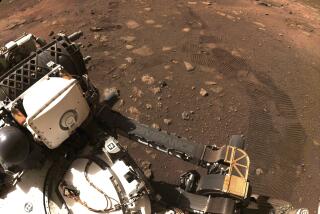Mars rover Curiosity set to ride biggest sand dune yet
NASA’s Mars rover Curiosity is poised to tip its wheels over the crest of a dune called Dingo Gap, down a path that could lead to a promising new target for the robotic explorer to drill. But the rover has remained perched on the edge as its team decided whether to take the plunge down potentially hazardous terrain.
“The rover today literally has its two front wheels at the crest of the dune … and if all goes well, we should be down and off of it tomorrow,” said Caltech geologist John Grotzinger, lead scientist for the Mars Science Laboratory mission. At about a yard high and 10 yards long, it could be the biggest sand dune ever crossed on Mars.
“We’re literally not over the hump yet with the sand dune,” he added, “but it’s looking very optimistic right now.”
If Curiosity gets the go-ahead tonight, the rover will roll its way down the sandy dune very carefully. If the wheels start to slip too much, it will pause rather than keep spinning and potentially digging itself into a hole, like a car wheel in a snowdrift.
The Mars Science Laboratory team at Jet Propulsion Laboratory in La Cañada Flintridge has been debating whether to keep Curiosity driving down what scientists are calling the “rapid transit route.” But recent unexpected damage to the rover’s wheels – a surprising number of scratches and scars in their thin metal – had them reevaluating the rocky terrain.
“That gave us concern,” Grotzinger said. “We expect to get damage to the wheels, but we were surprised at the rate.”
They think that’s in part because the harsh winds of Gale Crater, ideal for revealing fresh organic matter, have a drawback: They tend to whittle rocks down to pointy little pyramids perfect for piercing and scraping the rover’s wheels. And since Curiosity is much more massive than its predecessor Opportunity, all that weight bearing down on a tiny sharp point, over and over, might be doing more damage than scientists had expected, Grotzinger said.
The team members decided to take a sharp detour from the unforgiving rapid transit route and head along a route they called the “pink path,” but the problem was this very narrow pass standing in their way, filled with a slippery sand dune they named the Dingo Gap. They could try to cross it, but they weren’t even sure whether the terrain beyond it would be any easier on the wheels than the rapid transit route.
“At first we thought, ‘Oh, jeez, it’s blocked, we don’t want to do that -- it would be risky to cross it,’ ” Grotzinger said. “But then we’ve fretted some more about, ‘If we continued to drive straight, and we never looked beyond this dune to what the other side’s going to look like, we may regret it some day.’”
The concerns for Curiosity may appear to stem from the fate of the 2004 rover Spirit, which got caught in a sand trap in 2009 and never recovered. But Spirit was limping with a malfunctioning wheel, Grotzinger said. The present situation is actually more like the 2005 predicament of Spirit’s twin, Opportunity, which became temporarily trapped after its spinning wheels dug into a sand dune that the Mars Exploration Rover team gloomily named Purgatory.
But the team decided to risk climbing the dune and at least have a peek over its edge. They soon discovered that the terrain ahead looked far better than the rocky road of the rapid transit route.
If all goes well, Curiosity will keep heading toward a region called KMS-9, an area that they think could hold their next drilling target. KMS-9 could provide more signs of a life-friendly past – and maybe even different kinds of habitable environments from the one discovered in Yellowknife Bay.
ALSO:
Meet Kepler-413b, a wobbly planet with weird weather
Could future spaceships be built with artificial bone?
The secret to dolphin speed? It’s not skin-deep
Why do birds fly in a V? Endangered bird reveals amazing secret





